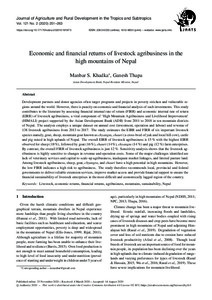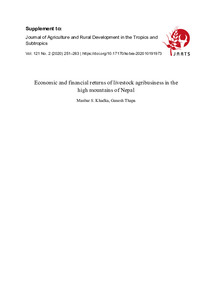| dcterms.abstract | Development partners and donor agencies often target programs and projects in poverty stricken and vulnerable regions around the world. However, there is paucity on economic and financial analysis of such investments. This study contributes to the literature by assessing financial internal rate of return (FIRR) and economic internal rate of return (EIRR) of livestock agribusiness, a vital component of ‘High Mountain Agribusiness and Livelihood Improvement’ (HIMALI) project supported by the Asian Development Bank (ADB) from 2011 to 2018 in ten mountain districts of Nepal. The analysis employs a unique dataset on annual cost (investment, operation and labour) and revenue of 138 livestock agribusiness from 2013 to 2017. The study estimates the EIRR and FIRR of six important livestock species namely, goat, sheep, mountain goat known as chyangra, chauri (a cross-bred of yak and local hill cow), cattle and pig raised in high uplands of Nepal. The overall EIRR of livestock agribusiness is 15% with the highest EIRR observed for sheep (18%), followed by goat (16%), chauri (14%), chyangra (14%) and pig (12%) farm enterprises. By contrast, the overall FIRR of livestock agribusiness is just 12%. Sensitivity analysis shows that the livestock agribusiness is highly sensitive to changes in revenue and operation costs. Some of the major challenges identified are lack of veterinary services and capital to scale-up agribusiness, inadequate market linkages, and limited pastureland. Among livestock agribusiness, sheep, goat, chyangra, and chauri has a high potential in high mountains. The low FIRR indicates a high risk to agribusiness. The study therefore recommends local, provincial and federal governments to deliver reliable extension services, improve market access and provide financial support to ensure the financial sustainability of livestock enterprises in the most difficult and economically lagged region of the country. | eng |



